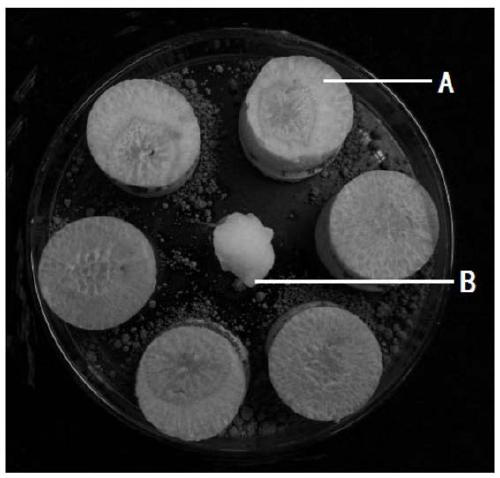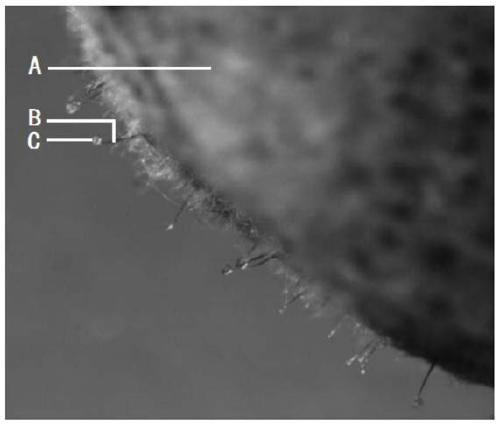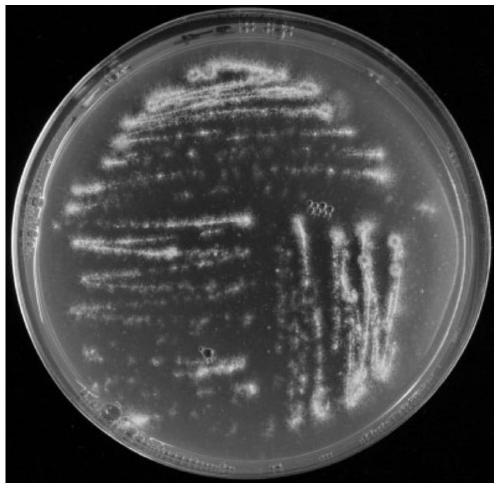A method for isolating the long beaker fungus from soil
A beak shell and soil technology, applied in the field of microbiology, can solve the problems of enrichment and separation of long beak shell fungus, difficulty in controlling the dilution factor of soil extract, and many experimental equipment and equipment. Separation and purification efficiency, low cost, and wide application range
- Summary
- Abstract
- Description
- Claims
- Application Information
AI Technical Summary
Problems solved by technology
Method used
Image
Examples
Embodiment 1
[0036] Embodiment 1: Separation and purification of the long beaked shell fungus
[0037] (1) Rinse fresh and healthy carrots with tap water, remove the skin and sterilize them in ethanol with a volume concentration of 75% for 1 to 2 minutes, dry the surface with clean napkins, and then cut them into thicknesses of 3 to 5 mm And uniform slices, and then use a 2.5cm diameter puncher to take a disc of equal diameter in the center of the carrot slices, and set aside;
[0038] (2) Place the carrot discs in step (1) in a petri dish with a diameter of 9 cm, place 12 carrot discs in each petri dish, overlap each other, and use an electronic balance to take it from Mengzi, Yunnan soil sample, 1g / part; place the weighed soil sample between two overlapping carrot discs, and place a ball of cotton soaked in sterile water in the center of the Petri dish to keep it moist (such as figure 1 ); placed in a constant temperature incubator at 26°C for 3 to 10 days, and observing the enrichment ...
Embodiment 2
[0041] Example 2: Identification of isolates
[0042] (1) Sequence identification
[0043]After the pure bacterium colony of the target bacterium that step (3) obtains is cultivated on the MYEA medium for 2 weeks, scrape the mycelia and The mixture of spores was extracted with the CTAB method for total DNA, and the extracted total DNA was amplified by PCR using the following primer pairs:
[0044] Upstream primer ITS1F: 5'-CTTGGTCATTTAGAGGAAGTAA-3' and
[0045] Downstream primer ITS4: 5'-TCCTCCGCTTATTGATATGC-3',
[0046] The amplified sequence is shown in SEQ ID No.1. The PCR products were detected by 1.5% agarose gel electrophoresis, and then sent to Biomed for sequencing, and the sequencing results were compared and analyzed in the NCBI database to further identify the isolates.
[0047] PCR reaction system:
[0048]
[0049]
[0050] PCR reaction program: pre-denaturation at 95°C for 5 min; followed by denaturation at 94°C for 45 s, annealing at 56°C for 40 s, ex...
PUM
| Property | Measurement | Unit |
|---|---|---|
| thickness | aaaaa | aaaaa |
| diameter | aaaaa | aaaaa |
Abstract
Description
Claims
Application Information
 Login to View More
Login to View More - R&D
- Intellectual Property
- Life Sciences
- Materials
- Tech Scout
- Unparalleled Data Quality
- Higher Quality Content
- 60% Fewer Hallucinations
Browse by: Latest US Patents, China's latest patents, Technical Efficacy Thesaurus, Application Domain, Technology Topic, Popular Technical Reports.
© 2025 PatSnap. All rights reserved.Legal|Privacy policy|Modern Slavery Act Transparency Statement|Sitemap|About US| Contact US: help@patsnap.com



